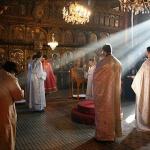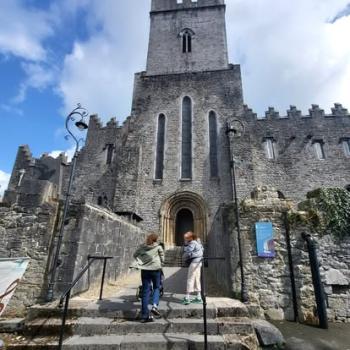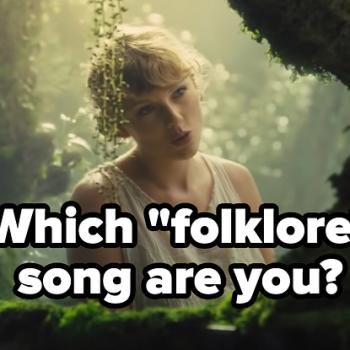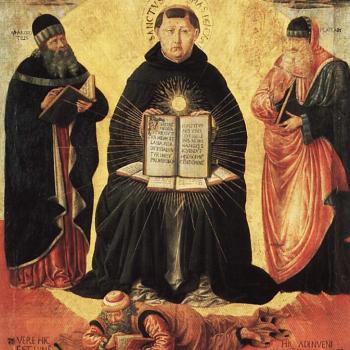The Catholic sacramental imagination shapes our world view.
It fuels our art placed in churches and museums throughout the world.
With such things as paintings and statues of St. Agatha holding a tray serving her two severed breasts,
Or of the Holy Child of Raffles reclining his head on a hard-human skull instead of a fluffy pillow.
The Catholic sacramental imagination helps us see the Gothic Revival Structure as made for the drama of the Latin Mass.
It helps us to see that the symbolic biblical lion looks like an icon of God, that was painted by some alien race.
And this worldview lets us see the living ikon and representative of God that views all this art and architecture.
Our Neighbor who makes the living God as visible and tangible as the Blessed Sacrament.
The Catholic sacramental imagination helps us hear God in the great silence settled over cities,
Helps us realize He is in the silence and not the chaotic noise surrounding all the silence.
It helps us see Our profession of Faith in the Creed as not just another list of what I believe,
But a Story of Who I Believe in.
And that Who was shaped and formed by the Virgin’s gentle motherly touch.

The Catholic sacramental imagination teaches us the art of Both/And.
We don’t have to sprinkle our writings with swears to prove how adult and sophisticated of a writer that we are.
But when it comes to our storytelling arts we don’t have to be more concerned
about our depiction of F-Bombs over the gory violence of real bombs.
And also the Figurative bombs we yell at each other in anger, that we place in our Catholic writings.
God sees the work of creation moved along by this imagination.
So, we should be busy using this gift for the Lord.
Working in Love teaching wiggling children to pray,
And praying for all our enemies and neighbors to be saved.
Writing and blogging away
With examples of this imagination at play,
In Patheos Catholic writers
Creating Today.
The Cordial Catholic by Albert Little
First Post: 12/14-Current
Cordial Catholic Podcast
One of the ever-bearing gifts of the Catholic Church is incredible depth of her teaching. Spanning over two thousand years the Church boasts incredible thinkers from Augustine to Aquinas; from Henri Nouwen to Cardinal Newman; from St. Francis of Assisi to, one of my personal favorites, St. Francis de Sales.
By praying, working in service, loving others, worshiping, and striving to find God in everything we do we can avoid becoming idle to the point of opening ourselves up to temptation.
Keep busy, St. Francis says, by doing God’s will.
Be busy for the Lord. In prayer, fasting, good works, and worship.
This is a sure fire formula for minimizing temptation.
K. Albert Little St. Francis de Sales’ Advice for Lent: Prepare to be Tempted (March 5, 2019) The Cordial Catholic @ Patheos Catholic
Cracks in Postmodernity by Stephen G. Adubato
First Post: 10/17-Current
The Catholic sexual imagination is anything but normal and boring-it’s weird, crazy, and at times, mysterious. The visibility of “private parts” in Catholic art bear witness to the divine Mystery in whose image we are made. The body is neither something to be ashamed of nor an object to be used for pleasure. Rather, the body holds the mark of its Creator, who invites us to use our bodies to participate in the divine work of sustaining this world and preparing us for the world beyond.
The strangest of the virgin martyrs is probably Agatha, who was martyred in Catania, Sicily in 251 under Decius. Yet another one of those rogue Christian girls who refused to marry a noble, she was jailed and endured a series of tortures before being killed, one of which involved her breast being chopped off. Agatha is often depicted in paintings and statues holding a tray serving two severed breasts, much to the confusion of many a Catholic youth who was dragged out of bed to go to Mass on Sunday morning.
Stephen G. Adubato, The Weird Catholic Sexual Imagination (December 9, 2017) Cracks in Postmodernity @ Patheos Catholic
The Dorothy Option by Elias Crim
First Post: 1/16- Current
Dorthy Option Books
The unimaginable has occurred. Not only in the form of a deadly virus sweeping the planet. But also as a Great Silence that has, for a time at least, settled over the cities.
It is not only that smog has lifted over Los Angeles, Tokyo, and everywhere else or that power usage is markedly down. In Punjab, India, one can see the mountain range of the Himalayas again in the distance. In our city parks, people are noticing the sound of birdcalls once again. The story of dolphins appearing in the newly blue-green canals of Venice is apparently an urban myth but, as the Italians say, Se non é vero, é ben travato (“If it’s not true, it should be.”) Seismologists are noticing that the drop in detectable noise in the earth’s crust is very noticeable, for both surface traffic and ocean traffic.
While humans are in a great pause, nature is taking a breath. Amidst great human suffering, with no discernible end in sight, we find ourselves — both the religious and those not — not merely in isolation but in something like an enforced silent retreat.
Elias Crim, How to Understand the Great Silence We’re In (April 13, 2020) The Dorothy Option @ Patheos Catholic
Faith on the Couch by Gregory K. Popcak
First Post 2/13 -June, 2020
Faith on the Couch Books
(When I lived in Steubenville, My friend had a cleaning company and I used to clean his house)
Praying with small children can be difficult. They tend to be wiggly and have short attention spans. When little ones are involved, it’s easy for family prayer time to seem more like…Wrestlemania. But you can have a meaningful prayer time with small children if you remember that little people need different spiritual food than bigger people.
Faith develops in different stages from early childhood, to middle childhood, adolescence, and young adulthood.
By understanding the spiritual food that a small child’s faith requires, you can help fill their hunger for God.
Rachael Popcak and Dr. Gregory Popcak Praying With Small Children (May 8, 2019) Faith on the Couch @ Patheos Catholic
The Global Catholic Review by Andrew Chesnut
First Post: 3/18 -Current
The Christ Child reclining his head on a hard human skull instead of a fluffy pillow. The childish innocence and doll-like cuteness of the Christ Child genre is retained here but unexpectedly juxtaposed with the most common memento mori – a human cranium. Catholics of course are most familiar with the death imagery of the adult Christ crucified on the Roman instrument of torture, the cross. But the Holy Infants of Prague and Atocha, among all the others, with their radiant countenance and baby fat evoke vibrant young life with no hint whatsoever of impending death and resurrection.
Andrew Chesnut Holy Child of Raffles – The Mexican Christ Child Asleep on a Skull (August 16, 2019) The Global Catholic Review @ Patheos Catholic
Jane the Actuary by Elizabeth Bauer
First Post: 7/13- Current
It seems that countless writers have decided that, not only is it perfectly appropriate to sprinkle swears throughout their writing (and presumably their everyday speech) but that to not to so would be inauthentic and inappropriate or simply childish.
We seem to need some class of words to show strong feelings. But there’s no reason why that set of words can’t be “frickin’” or “dangnabit” or even “what the covfefe” (which I’m inclined towards using in an all-purpose manner these days) rather than f*** or the like. Or, rather, why f*** can’t be reserved for truly extreme situations, like, say, a car accident. But, then, I suppose, it fits with the fact that we seem to have lost all sense of proportion, and treat every undesirable event as if it were as horrific as, well, whatever horrific thing you can imagine.
Elizabeth Bauer “Swears” and the social compact June 19, 20170 Jane the Actuary @ Patheos Catholic
Jappers and Janglers by Chase Padusniak
First Post: 2/16 -Current
Unsurprisingly, I am surrounded by Catholic bloggers: opponents, friends, frenemies, and every other color of the proverbial Apostolic rainbow. And, frankly—for a long time and from all sides—the sheer intensity of it all has troubled me. Why is everyone yelling so much? What’s with the name-calling?
Obviously anger can easily overcome us; being charitable can be very hard. And yet, God promises us more than pettiness and the gnashing of teeth.
Chase Padusniak, Why Are You Yelling? Or the Failure of Catholic Blogging (July 16, 2016) Jappers and Janglers @ Patheos Catholic
Kate O’Hare’s Pax Culturati by Kate O’Hare
First Post: 2/15 -Current
She writes for and edits for Family Theater’s Faith & Family Media Blog
The Catholic sacramental worldview informs everything we do. We don’t just work in words; we also work in symbol and metaphor. For us, things like water, smoke, candles, bells, chant, icons, images of saints, crucifixes — even ordinary objects, like a cup or keys, or nature itself — hold deep spiritual meaning and resonance.
The Catholic imagination has a whole language of images to draw upon. Our literature, art and movies don’t need to be sermons. We can make movies about Christ that depict Him and His followers, or we can make movies about Christ that never mention Him at all.
As in “The Lord of the Rings,” by Catholic writer J.R.R. Tolkien, we can read the symbolism behind the story, interpreting it back into Catholicism, like translating from one language to another.
Kate O’Hare Alfred Hitchcock: Cradle Catholic, Catholic Revert or Just Simply Catholic? (August 13, 2016) Kate O’Hare’s Pax Culturati @ Patheos Catholic
Labyrinthine Mind by Pablo Migone
First Post: 8/08 – Last Post: Current
Christian art fuels so much tourism throughout the world because people are attracted to its beauty. The Sistine Chapel and Saint Peter Basilica may be the most prominent, but churches and museums throughout the world attract millions of visitors, both believers and nonbelievers. We must find effective ways so that our rich and beautiful artistic heritage, which is inspired by the Gospel, continues to lead souls to encounter Christ.
Father Pablo Migone Beauty to evangelize, (April 25, 2019) Labyrinthine Mind @ Patheos Catholic
A Little Bit of Nothing by Henry Karlson
First Post: 2/16 -Current
Book: The Eschatological Judgment of Christ
The Hope of Universal Salvation and the Fear of Eternal Perdition in the Theology of Hans Urs von Balthasar
By Henry C. Anthony Karlson, III
Love cannot bear that. We must pray for all,” St. Silouan of Mount Athos once told a hermit who asked him why he was known to pray for those presumed to be damned. Instead of thinking everyone deserved to be damned so that we should not be concerned if anyone should perish in hell, St. Silouan believed that the Christian response was the response of love, the response of Christ. Love does what it can for the salvation of all. Because Christ died for all (cf. 2 Cor. 5:15), we should desire that all should be saved. While it might seem highly unlikely, we must pray for and hope for the salvation of all, for that is the hope of love. It is because God is love that Christ came to the world to save sinners; he came, not just for a few, but for all, and so we are to pray for all:
Henry Karlson Love All, Pray For All, and Hope For All, Because Grace Is Available To All (May 10, 2016) A Little Bit of Nothing @ Patheos Catholic
Lost in a One-Acre Wood by Jack Hartjes
First Post: 5/18 -Current
Book: Read The Way You Talk: A Guide for Lectors (January 1, 2004)
The first thing our visitor notices about the Creed is that it’s another story. It’s not an essay detailing things I believe. One little word changes everything. It’s what, or rather Who, I believe IN. When I say “I believe in you,” I’m not saying “I believe you exist.” This is not stating a fact, it’s putting myself into your story and on your side. With the first sentence of the Creed, I declare my loyalty to and trust in God, whose story includes some amazing deeds. I put myself in that story, which is not finished yet.
Jack Hartjes The Creed, a Story Not an Essay (November 13, 2019) Lost in a One-Acre Wood @ Patheos Catholic
Mudblood Catholic by Gabriel Blanchard
First Post: 7/19 – Current
Amazon Page
Even for those of us who believe in God, making him affectively real to ourselves—interacting with him as a concrete person that we relate to—is incredibly difficult, because he is rarely if ever present to our senses (save in the Blessed Sacrament, and there he is concealed). Mystical experiences are rare.
But our neighbor, whom we are told in no uncertain terms is God’s ikon and representative, is right there for us to practice on. How we love our neighbor reveals how we love God. We must come back and back and back to this; it is the incarnation of charity; it is the check on our potentially bottomless introspection, scrupulosity, and legalism. If we would be united in love to God, who is immeasurably other, we must begin by opening our hearts to those who are measurably other.
Gabriel Blanchard The Mark of the Pharisee (October 28, 2019) Mudblood Catholic @ Patheos Catholic
On the Catholic Beat by Brian Fraga
First Post: -11/19 – Current
Looking up at St. Mary’s arches and its high-vaulted ceiling, I had the insight that this magnificent Gothic Revival structure was specifically built for the drama of the Latin Mass. The Irish immigrants who built St. Mary’s in 1869 did so with the Latin Mass in mind — a Mass that serves as a reminder of God’s majesty and the glories that await the faithful in heaven.
I still find Mass in the ordinary form to be edifying and more in line with my own spirituality, which I would describe as being rooted firmly in the Second Vatican Council. But the Catholic Church is a big tent, and there is plenty of room for different spiritualities, including for our brothers and sisters who own a Latin missal.
Brian Fraga is a contributing editor for Our Sunday Visitor.
Brian Fraga Experiencing the beauty of the Latin Mass firsthand (November 13, 2019) On the Catholic Beat @ Patheos Catholic
Steel Magnificat by Mary & Michael Pezzulo
First Post: 3/16 Current
I don’t think I’d ever understood before why the lion is called the king of beasts and so often associated with God and the angels, but I knew just then. It’s not just that a lion is an enormous predator with a voice that can carry for five miles– it’s the face. There is no way for me to adequately describe the experience of staring at a lion’s face, in person.
Looking at a photo doesn’t carry the same weight, just as hearing a recording of a lion’s roar can’t convey the experience of hearing it behind you when you didn’t know there was a lion nearby. It’s partly to do with the symmetry of that face: the white patches under the eyes, the dark triangle of the nose, the crowning halo of the mane. A lion doesn’t look like a real animal. A lion looks like an icon of God, painted by some alien race.
Mary Pezzulo The Lion is Not Real: a Lesson About Faith (November 30, 2019) Steel Magnificat @ Patheos Catholic
Synapses of the Soul by Sofia Carozza
First Post: 8/18 – Current
Writing a Book
The human person develops through relationships with others, just as Christ did through the love of his mother Mary. The Virgin’s touch and voice helped Christ learn, think and speak; the coordination of their heartbeats helped him develop emotional and physiological regulation; her stress response supported his own; the synchrony of her brain waves with his shaped his attention and memory. Through the love of his young mother, this child grew into the man who died on the Cross for our salvation.
Sofia Carozza The Advent Corrective to Locke’s Lonely Liberalism (December 03, 2018) Synapses of the Soul @ Patheos Catholic
Catholics Outside Patheos Catholics but Still on Patheos
Sister Rose at the Movies by Sister Rose On Entertainment Channel
10/03 – May, 2020
Bibliography
Our current American culture presents another paradox: differing religious moral codes that call themselves Christian. Publicists, whose target audience is the evangelical community, organized the screening I attended. Evangelicals were in attendance as well as veterans. A former military chaplain was present in case any of the vets needed to talk.
The publicist triumphantly announced that due to negative feedback about the film’s language from test audiences in the evangelical community the filmmakers edited out every single bad word in the film. There was a small reaction rather than cheers to this statement because I think the veterans knew this was ridiculous or she embarrassed them because they actually used such language. It was such a surreal, weird moment for me. I wanted to tell her: You can look at horrific battle scenes, limbs being torn off, heads exploding, blood and extreme suffering everywhere — and an occasional swear word offends you? Don’t you think that your value system is a tad skewed if you believe that God is more offended by bad words uttered in the worst of circumstances than reality-defying violence and war? ….
Sister Rose ‘Hacksaw Ridge,’ for all its heroism and love, remains a paradox (November 3, 2016) Sister Rose at the Movies @ Entertainment Channel
The Working Catholic by William Droel On Faith and Work Channel
1/15 – Present
Publications
Work is participation in God’s ongoing creation. God’s command in Genesis to “fill the earth and subdue it,” is a call to mobilization, Wyszynski writes. “When God announced the summons He saw the earth as it would become through work. God saw [all of us] who would go through the world in submissive service to Him, adding ever more perfection wrought by His power in work, to what God had made.”
William Droel Theology of Work (June 28, 20180 The Working Catholic @ Patheos Faith and Work

















